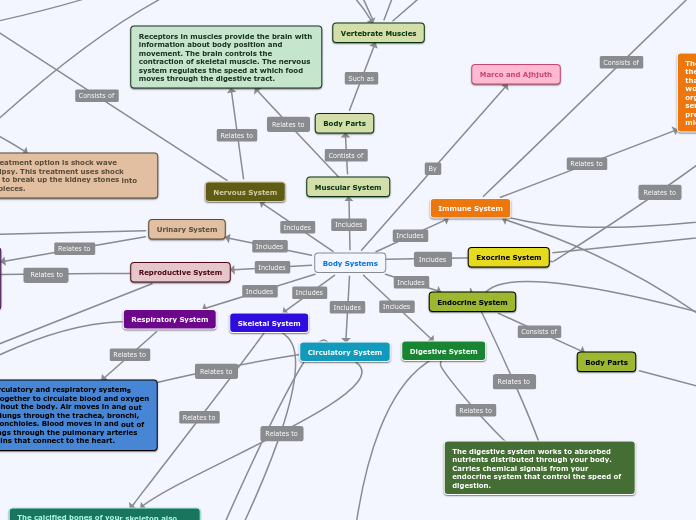Body Systems
Circulatory System
Body Parts

Heart
A muscular organ in most animals, which pumps blood through the blood vessels of the circulatory system.[1] Blood provides the body with oxygen and nutrients, as well as assisting in the removal of metabolic wastes.
Located between the lungs, in the middle compartment of the chest.

Lungs
The pulmonary arteries carry deoxygenated blood to the lungs, where carbon dioxide is released and oxygen is picked up during respiration. Arteries are further divided into very fine capillaries which are extremely thin-walled. The pulmonary vein returns oxygenated blood to the left atrium of the heart.
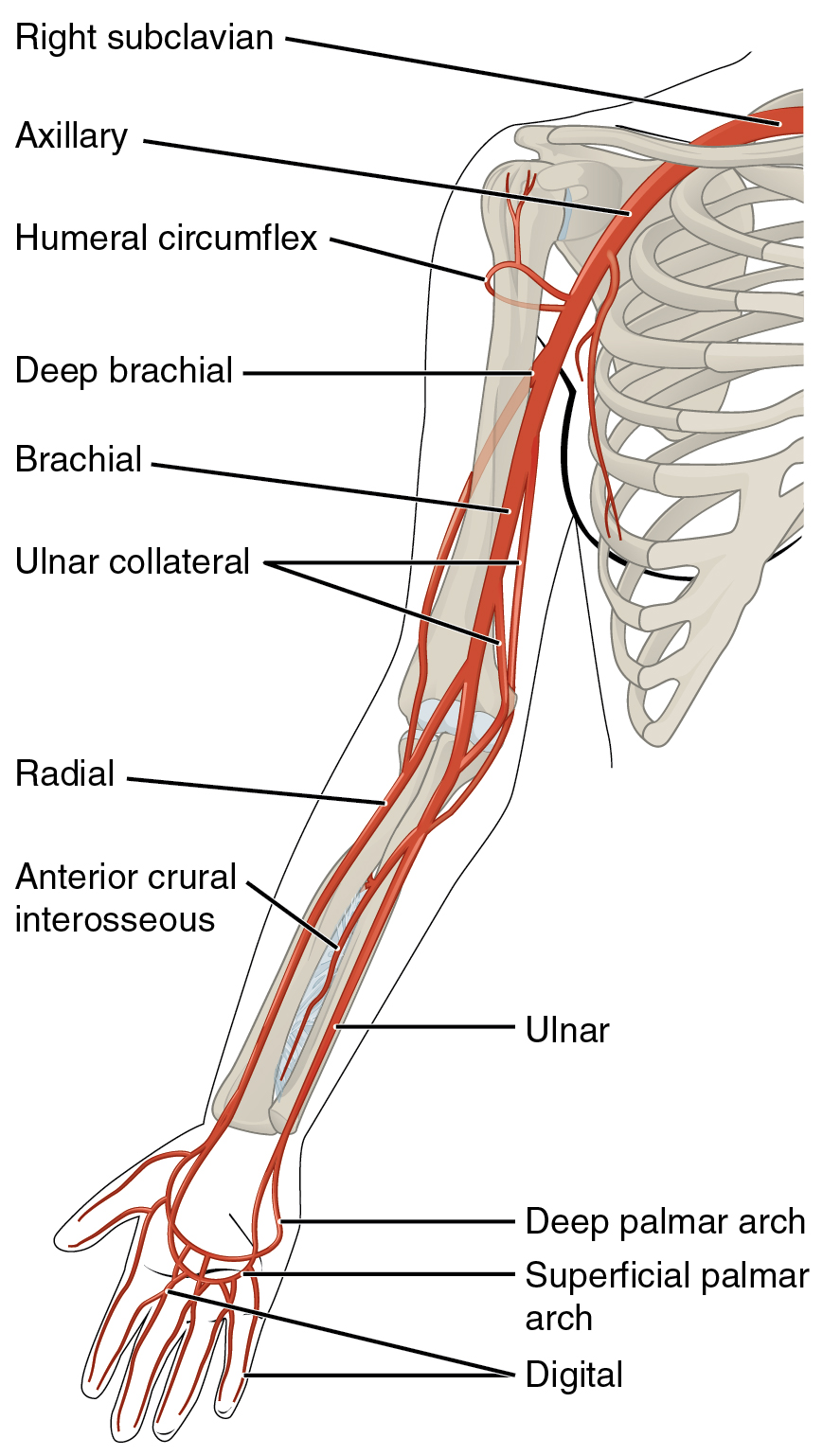
Arteries
A blood vessel that takes blood away from the heart to all parts of the body
Oxygenated blood; the two exceptions are the pulmonary and the umbilical arteries, which carry deoxygenated blood to the organs that oxygenate it.
Part of the circulatory system, which is responsible for the delivery of oxygen and nutrients to all cells, as well as the removal of carbon dioxide and waste products, the maintenance of optimum blood pH, and the circulation of proteins and cells of the immune system.
/vascular-system-veins-56c87fa03df78cfb378b3e7c.jpg)
Veins
Blood vessels that carry blood toward the heart. Most veins carry deoxygenated blood from the tissues back to the heart; exceptions are the pulmonary and umbilical veins, both of which carry oxygenated blood to the heart. In contrast to veins, arteries carry blood away from the heart.
Less muscular than arteries and are often closer to the skin. There are valves in most veins to prevent backflow.

Coronary Vessels
Coronary circulation is the circulation of blood in the blood vessels that supply the heart muscle (myocardium). Coronary arteries supply oxygenated blood to the heart muscle, and cardiac veins drain away the blood once it has been deoxygenated.

Portal Vessels
Blood vessels that carry blood from the gastrointestinal tract, gallbladder, pancreas and spleen to the liver. This blood contains nutrients and toxins extracted from digested contents.
Coronary artery disease develops when the major blood vessels that supply your heart with blood, oxygen and nutrients (coronary arteries) become damaged or diseased.
Various drugs can be used to treat coronary heart disease such as aspirin or nitroglycerin (blood thinners)
Digestive System
Body Parts

Mouth
Once you start chewing and breaking the food down into pieces small enough to be digested, more saliva is produced. It contains substances including enzymes that begin the process of breaking down food into a form your body can absorb and use.

Salivary Glands
The salivary glands produce saliva, which keeps the mouth and other parts of the digestive system moist. It also helps break down carbohydrates.

Esophagus
It forms an important piece of the gastrointestinal tract and functions as the conduit for food and liquids.

Liver
The liver's main job is to filter the blood coming from the digestive tract, before passing it to the rest of the body.
Detoxifies chemicals and metabolizes drugs.

GallBladder
Its primary function is to store and concentrate bile, a yellow-brown digestive enzyme produced by the liver.

Pancreas
Enzymes, or digestive juices, are secreted by the pancreas into the small intestine. There, it continues breaking down food that has left the stomach.

Large Intestine
recovery of water and electrolytes, formation and storage of faeces and fermentation of some of the indigestible food matter by bacteria.

Small Intestine
The main function of the small intestine is absorption of nutrients and minerals from food.

Appendix
Does absolutely nothing.

Rectum
The key role of the rectal ampulla is to act as a temporary storehouse for feces.

Anus
The lining of the upper anus is specialized to detect rectal contents. It lets you know whether the contents are liquid, gas, or solid.
Dysentery is an inflammatory disease of the intestine, especially of the colon, which always results in severe diarrhea and abdominal pains.
Flagyl, or metronidazole, is often used to treat dysentery. It treats both bacteria and parasites. If lab results are unclear, the patient may be given a combination of antibiotic and amoebicidal medications
The digestive system works to absorbed nutrients distributed through your body. Carries chemical signals from your endocrine system that control the speed of digestion.
Endocrine System
Body Parts
Glands

Pineal
The pineal gland produces melatonin, a serotonin-derived hormone which modulates sleep patterns

Pituitary
The anterior pituitary gland produces the hormones and releases them into the bloodstream

Thyroid
The thyroid gland produces hormones that regulate the body's metabolic rate as well as heart and digestive function, muscle control, brain development, mood and bone maintenance.

Parathyroids
The parathyroid glands are four tiny glands, located in the neck, that control the body's calcium levels. Each gland is about the size of a grain of rice

Adrenals
The adrenal cortex—the outer part of the gland—produces hormones that are vital to life, such as cortisol (which helps regulate metabolism and helps your body respond to stress) and aldosterone (which helps control blood pressure).

Ovaries
Second, ovaries produce female reproductive hormones called estrogen and progesterone, and some lesser hormones called relaxin and inhibin. There are three different types of estrogen: estrone, estradiol and estriol.

Testes
the testes also have the distinction of being an endocrine gland because they secrete testosterone—a hormone that is vital to the normal development of male physical characteristics.
A hormone imbalance may occur if this feedback system has trouble keeping the right level of hormones in the bloodstream, or if your body doesn't clear them out of the bloodstream properly.
Use different horomone tablets or doctors can suggest new blood work for you
Immune System
Body Parts

Tonsils and thymus
Their defense cells come into contact with pathogens especially soon, and can activate the immune system immediately.
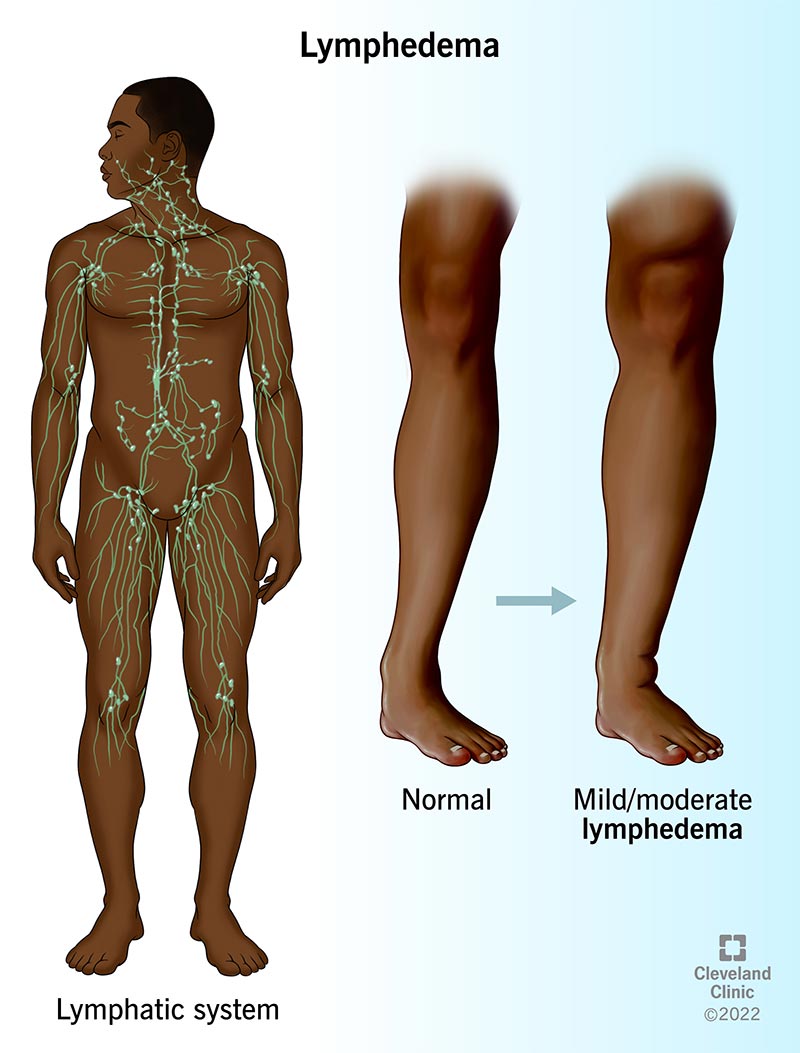
Lymph nodes and vessels
The lymphatic system of lymph nodes and vessels is important for continually exchanging substances between the blood and the tissue in the body.
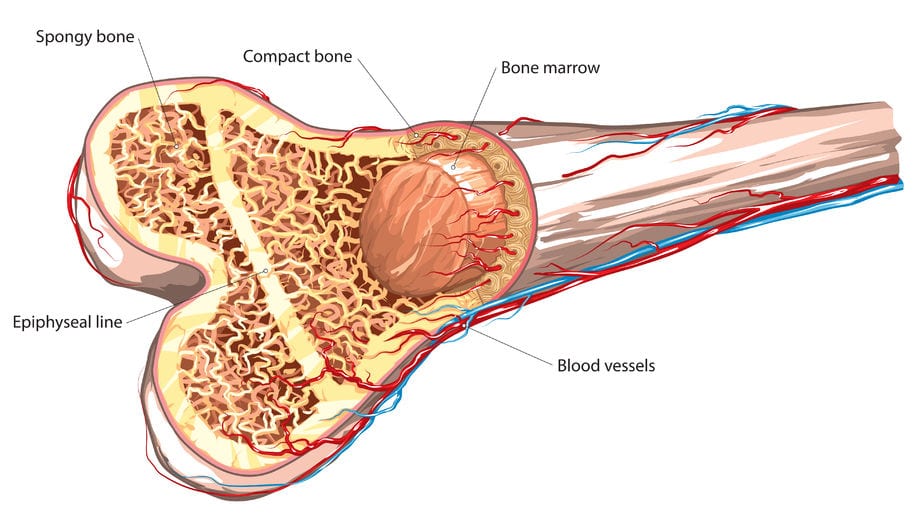
Bone marrow
Bone marrow is a sponge-like tissue situated inside of the bones. Most defense cells are produced and then also multiply here.
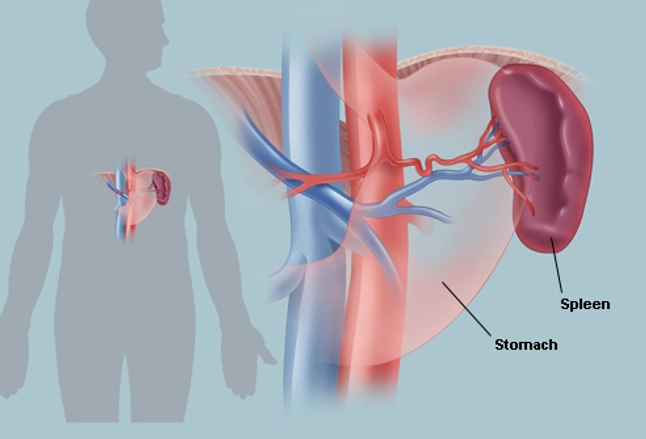
The spleen
In the unborn child, the spleen mainly produces blood and defense cells. After birth this organ is mainly responsible for removing blood cells and for specific defense functions.

White blood cells
White blood cells are the cells of the immune system that are involved in protecting the body against both infectious disease and foreign invaders.
Autoimmune disease
Treatments can’t cure autoimmune diseases, but they can control the overactive immune response and bring down inflammation or at least reduce pain and inflammation. Drugs used to treat these conditions include: ibuprofen and naproxen
The skin of the integumentary system helps the immune system because it is the skin that serves as a barrier between the outside world and the internal organs of an organism. Thus, the integumentary system serves as a protective covering that helps to prevent harmful substances, viruses, or microbes from entering the body.
Muscular System
Body Parts
Vertebrate Muscles
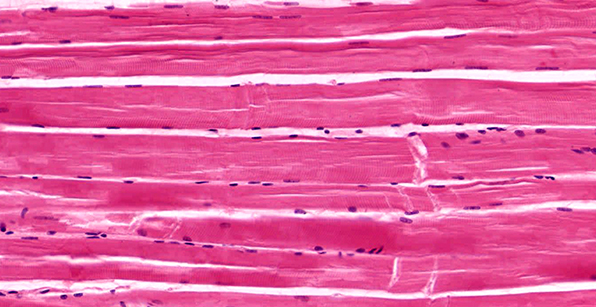
Skeletal Muscle
A form of striated muscle tissue.
Under the voluntary control of the somatic nervous system.
Actively control its function.
Attached to bones by bundles of collagen fibers known as tendons.
Muscle fibers that are cylindrical and have more than one nucleus.
Multiple mitochondria to meet energy needs.
Multiple bundles (fascicles) of cells joined together called muscle fibers.
Fibers and muscles are surrounded by connective tissue layers called fasciae.
The fusion of developmental myoblasts in a process known as myogenesis
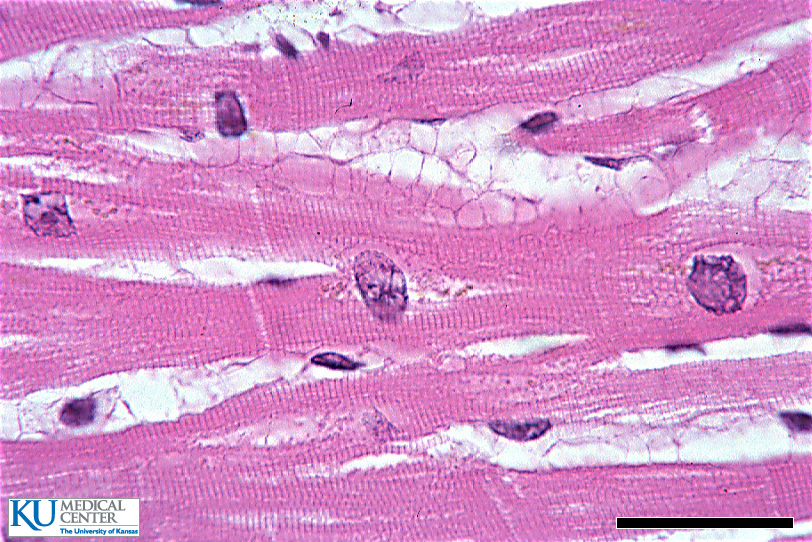
Cardiac Muscle
Heart muscle and myocardium.
An involuntary, striated muscle that constitutes the main tissue of the walls of the heart.
A thick middle layer between the outer layer of the heart (the epicardium) and the inner layer (the endocardium), with blood supplied from the coronary circulation.
In a similar manner to skeletal muscle.
Responsible for pumping blood to the blood vessels in your body.

Smooth Muscle
An involuntary non-striated muscle.
Two subgroups; the single unit (unitary) and multiunit smooth muscle.
Cells that are found in the walls of hollow organs.
Stomach, intestines, urinary bladder and uterus, and in the walls of passageways, such as arteries and veins of the circulatory system, and tracts of the respiratory, urinary, and reproductive systems.
Also present in the eyes and are able to change the size of the iris and alter the shape of the lens.
Cells that cause hair in the skin to stand erect in response to cold temperature or fear.
Nervous System
Body Parts
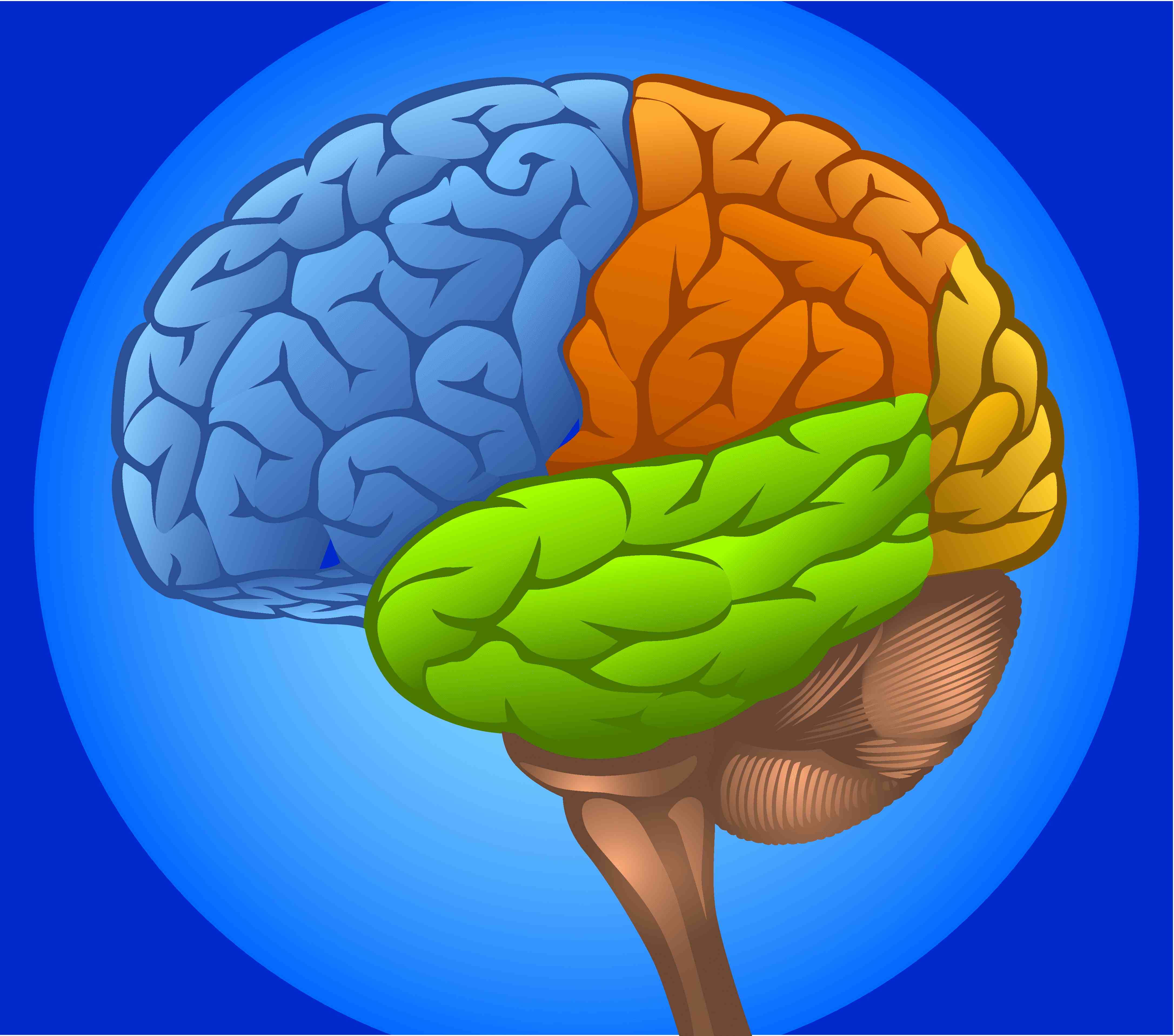
Brain
It controls coordination and balance. The brain stem sits beneath your cerebrum in front of your cerebellum. It connects the brain to the spinal cord and controls automatic functions such as breathing, digestion, heart rate and blood pressure.

Retina
The retina is a thin layer of tissue that lines the back of the eye on the inside. It is located near the optic nerve. The purpose of the retina is to receive light that the lens has focused, convert the light into neural signals, and send these signals on to the brain for visual recognition.

Spinal Cord
The brain and spinal cord are your body's central nervous system. The brain is the command center for your body, and the spinal cord is the pathway for messages sent by the brain to the body and from the body to the brain.

Cervical Nerves
Cervical Nerves control the head and neck, including movements forward, backward, and to the sides.

Thoracic nerves
The thoracic nerves refer to the cluster of nerve fibers found in the upper body, particularly within the chest region. These nerve fibers are considered spinal nerves, which carry and transmit information between the spinal cord and parts of the body.

Lumbar Nerves
These lumbar vertebrae contain spinal cord tissue and nerves which control communication between the brain and the legs.

Sacral Nerves
One spinal nerve plexus, called the sacral plexus, contains nerves that innervate the lower half of your body, including parts of your pelvis, the backs of your thighs, and most of your calves, ankles, and feet.
Paralysis is the loss of muscle function in part of your body. It happens when something goes wrong with the way messages pass between your brain and muscles.
Physical therapy uses treatments such as heat, massage, and exercise to stimulate nerves and muscles.
Occupational therapy concentrates on ways to perform activities of daily living.
Mobility aids include manual and electric wheelchairs and scooters.
Supportive devices include braces, canes, and walkers.
Assistive technology such as voice-activated computers, lighting systems, and telephones.
Adaptive equipment such as special eating utensils and controls for driving a car.
Receptors in muscles provide the brain with information about body position and movement. The brain controls the contraction of skeletal muscle. The nervous system regulates the speed at which food moves through the digestive tract.
Urinary System
Body Parts
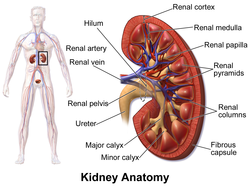
Kidney
Two bean-shaped organs, each about the size of a fist. They are located just below the rib cage, one on each side of your spine.
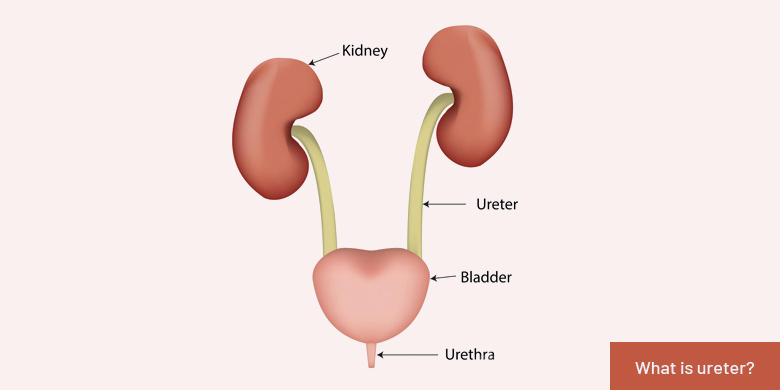
Ureters
Tubes made of smooth muscle fibers that propel urine from the kidneys to the urinary bladder. In the adult, the ureters are usually 25–30 cm long and around 3–4 mm in diameter.
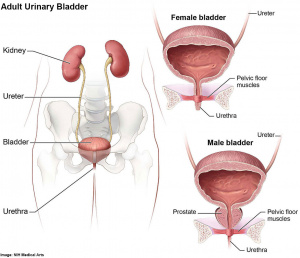
Urinary bladder
A hollow muscular organ in humans and some other animals that collects and stores urine from the kidneys before disposal by urination. In the human the bladder is a hollow muscular, and distensible organ, that sits on the pelvic floor.
A kidney stone is a hard, crystalline mineral material formed within the kidney or urinary tract.
One treatment option is shock wave lithotripsy. This treatment uses shock waves to break up the kidney stones into small pieces.
In males the penis serves as a common passage for urine and sperms.
In females the vagina serves as a common passage for urine and also aids in the child birth. It also serves as a passage for menstrual flow
Reproductive System
Genders
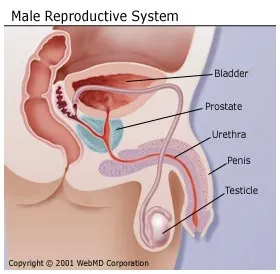
Male Organs

Penis
The primary sexual organ that male animals use to inseminate sexually receptive mates (usually females and hermaphrodites) during copulation.

Scrotum
An anatomical male reproductive structure that consists of a suspended dual-chambered sack of skin and smooth muscle that is present in most terrestrial male mammals and located under the penis.

Testicles
The male reproductive gland or gonad in all animals, including humans. It is homologous to the female ovary.
Are to produce both sperm and androgens, primarily testosterone.

Epididymis
A tube that connects a testicle to a vas deferens in the male reproductive system. It is present in all male reptiles, birds, and mammals. It is a single, narrow, tightly-coiled tube in adult humans, 6 to 7 meters in length connecting the efferent ducts from the rear of each testicle to its vas deferens.

Vas deferens
Also called ductus deferens.
Part of the male reproductive system of many vertebrates. These ducts transport sperm from the epididymis to the ejaculatory ducts in anticipation of ejaculation.

Ejaculatory ducts
Paired structures in male anatomy
Formed by the union of the vas deferens with the duct of the seminal vesicle. They pass through the prostate, and open into the urethra at the seminal colliculus. During ejaculation, semen passes through the prostate gland, enters the urethra and exits the body via the urinary meatus.

Urethra
A tube that connects the urinary bladder to the urinary meatus for the removal of urine from the body. In males, the urethra travels through the penis and also carries semen.

Seminal vesicles
A pair of simple tubular glands posteroinferior to the urinary bladder of some male mammals.
Located within the pelvis.

Prostate gland
A compound tubuloalveolar exocrine gland of the male reproductive system in most mammals. The function of the prostate is to secrete a slightly alkaline fluid, milkly or white in appearance, that in humans usually constitutes roughly 30% of the volume of semen along with spermatozoa and seminal vesicle fluid.

Bulbourethral glands
One of two small exocrine glands in the reproductive system of many male mammals.

Female Organs

Ovaries
Organs found in the female reproductive system that produces ovum. When released, this travels down the fallopian tube into the uterus, where it may become fertilized by a sperm.

Fallopian tubes
The passage of egg cells from the ovaries to the uterus.
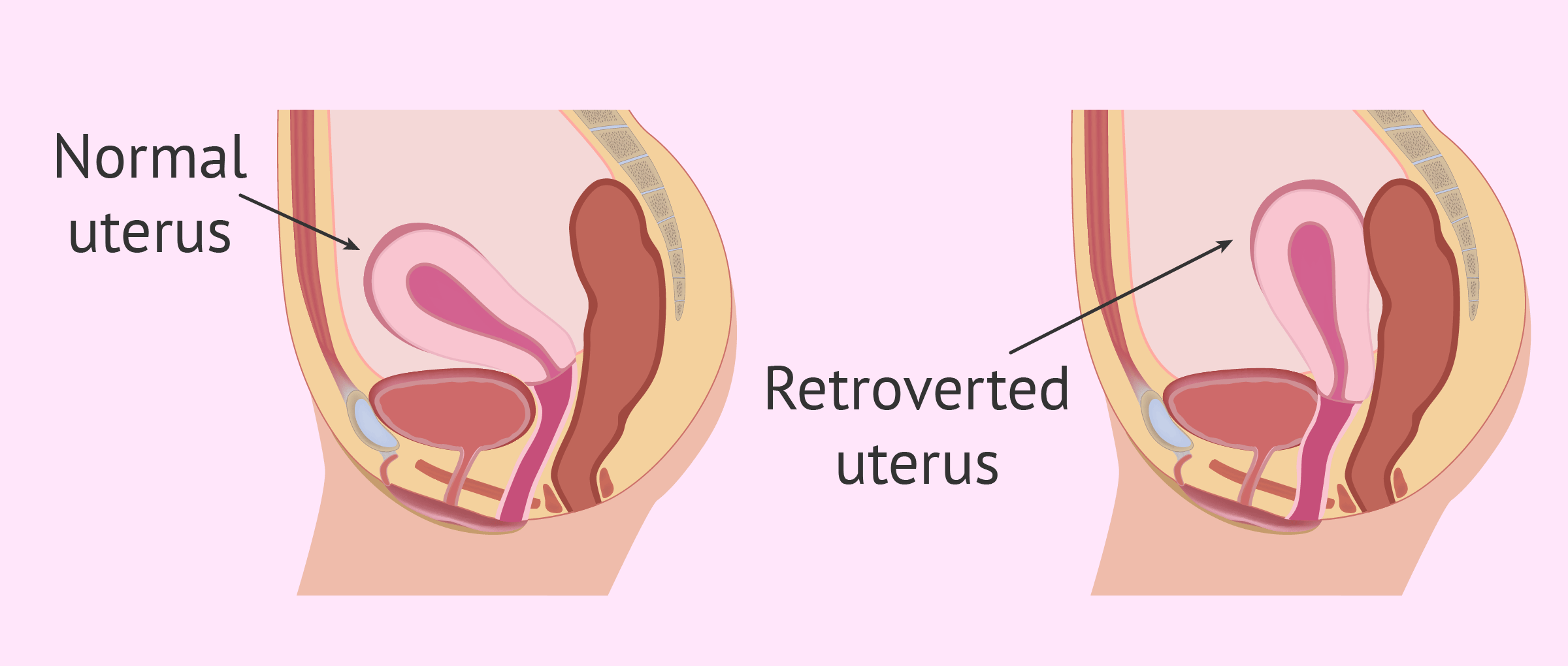
Uterus
A major female hormone-responsive secondary sex organ of the reproductive system in humans. In the human, the lower end of the uterus, the cervix, opens into the vagina, while the upper end, the fundus, is connected to the fallopian tubes.

Vagina
The elastic, muscular part of the female genital tract.
For sexual intercourse and birth

Vulva
The external female sex organs.
The mons pubis, labia majora, labia minora, clitoris, vestibular bulbs, vulval vestibule, urinary meatus, the vaginal opening, and Bartholin's and Skene's vestibular glands.

Mammary glands
An exocrine gland in humans and other mammals that produces milk to feed young offspring.

Breasts
One of two prominences located on the upper ventral region of the torso of primates. In females, it serves as the mammary gland, which produces and secretes milk to feed infants.
Ectopic pregnancy is a complication of pregnancy in which the embryo attaches outside the uterus.
Surgery is used to remove the pregnancy, usually along with the affected fallopian tube.
Skeletal System
Body Parts

Muscles
Soft tissue found in most animals. Muscle cells contain protein filaments of actin and myosin that slide past one another, producing a contraction that changes both the length and the shape of the cell. Muscles function to produce force and motion. They are primarily responsible for maintaining and changing posture, locomotion, as well as movement of internal organs, such as the contraction of the heart and the movement of food through the digestive system via peristalsis.

Cartilage
A resilient and smooth elastic tissue, a rubber-like padding that covers and protects the ends of long bones at the joints, and is a structural component of the rib cage, the ear, the nose, the bronchial tubes, the intervertebral discs, and many other body components. It is not as hard and rigid as bone, but it is much stiffer and much less flexible than muscle.
The matrix of cartilage is made up of glycosaminoglycans, proteoglycans, collagen fibers and, sometimes, elastin.

Tendons
A tough band of fibrous connective tissue that usually connects muscle to bone and is capable of withstanding tension. Tendons are similar to ligaments; both are made of collagen. Ligaments join one bone to bone, while tendons connect muscle to bone for a proper functioning of the body.

Ligaments
The fibrous connective tissues that connects bones to other bones.

Joints
The connection made between bones in the body which link the skeletal system into a functional whole.
Osteoporosis is a bone disease that occurs when the body loses too much bone, makes too little bone, or both.
Some hormone like medications are approved for preventing and treating osteoporosis, such as raloxifene (Evista).
The calcified bones of your skeleton also work with the circulatory system. Marrow inside of your bones helps produce the cells inside of you blood. Both red blood cells and white blood cells are created in your bones.
Respiratory System
The circulatory and respiratory systems work together to circulate blood and oxygen throughout the body. Air moves in and out of the lungs through the trachea, bronchi, and bronchioles. Blood moves in and out of the lungs through the pulmonary arteries and veins that connect to the heart.
Marco and Ajhjuth

Salivary
The salivary glands produce saliva, which keeps the mouth and other parts of the digestive system moist.
Exocrine System
Body Parts

Sweat
Sweating is a bodily function that helps regulate your body temperature. Also called perspiration, sweating is the release of a salt-based fluid from your sweat glands.
Changes in your body temperature, the outside temperature, or your emotional state can cause sweating. The most common areas of sweating on the body include:
- armpits
- face
- palms of the hands
- soles of the feet

Mammary
The mammary gland is a gland located in the breasts of females that is responsible for lactation, or the production of milk. Both males and females have glandular tissue within the breasts; however, in females the glandular tissue begins to develop after puberty in response to estrogen release. Mammary glands only produce milk after childbirth.

Prostate
The prostate gland is a male reproductive organ whose main function is to secrete prostate fluid, one of the components of semen.

Gastric
Gastric gland, any of the branched tubules in the inner lining of the stomach that secrete gastric juice and protective mucus.

Bile-producing glands of the liver
Bile, required for the digestion of food, is secreted by the liver into passages that carry bile toward the hepatic duct, which joins with the cystic duct to form the common bile duct, which opens into the intestine.

Ceruminous
Ceruminous gland They are classed as apocrine glands. The glands drain into larger ducts, which then drain into the guard hairs that reside in the external auditory canal. Here they produce cerumen, or earwax, by mixing their secretion with sebum and dead epidermal cells.

Lacrimal
The lacrimal gland is located within the orbit above the lateral end of the eye. It continually releases fluid which cleanses and protects the eye's surface as it lubricates and moistens it.

Sebaceous
Sebaceous glands secrete the oily, waxy substance called sebum that is made of triglycerides, wax esters, squalene, and metabolites of fat-producing cells. Sebum waterproofs and lubricates the skin and hair of mammals.

Mucous
Mucus serves to protect epithelial cells in the respiratory, gastrointestinal, urogenital, visual, and auditory systems
Exocrine pancreatic insufficiency occurs when the pancreas does not produce enough of the enzymes that aid digestion.
This condition can lead to poor absorption of nutrients, weight loss, and a shortage of vitamins.
Pancreatic enzyme replacement therapies are coated pills often made from pig pancreas juices.
PERTs can help you better absorb fats from your foods, ease symptoms like stomach upset or oily stools, and just help you feel better overall.
Inflammatory myopathies which
causes weakining and inflammation of
skeletal muscles.
Can be treated not cured by using
high doses of corticosteroid drugs
to reduce swelling.
Body Parts

Mouth
Once you start chewing and breaking the food down into pieces small enough to be digested, more saliva is produced. It contains substances including enzymes that begin the process of breaking down food into a form your body can absorb and use.
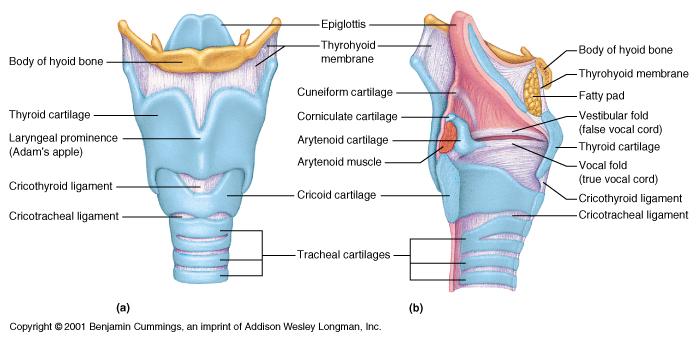
Pharynx
The part of the throat behind the mouth and nasal cavity and above the esophagus and larynx, or the tubes going down to the stomach and the lungs. The human pharynx is conventionally divided into three sections: the nasopharynx, oropharynx, and laryngopharynx. It is also important in vocalization. In humans, two sets of pharyngeal muscles form the pharynx and determine the shape of its lumen. They are arranged as an inner layer of longitudinal muscles and an outer circular layer.

Larynx
An organ in the top of the neck of tetrapods involved in breathing, producing sound, and protecting the trachea against food aspiration. The larynx houses the vocal folds, and manipulates pitch and volume, which is essential for phonation. It is situated just below where the tract of the pharynx splits into the trachea and the esophagus.
The process by which the vocal folds produce certain sounds through quasi-periodic vibration.
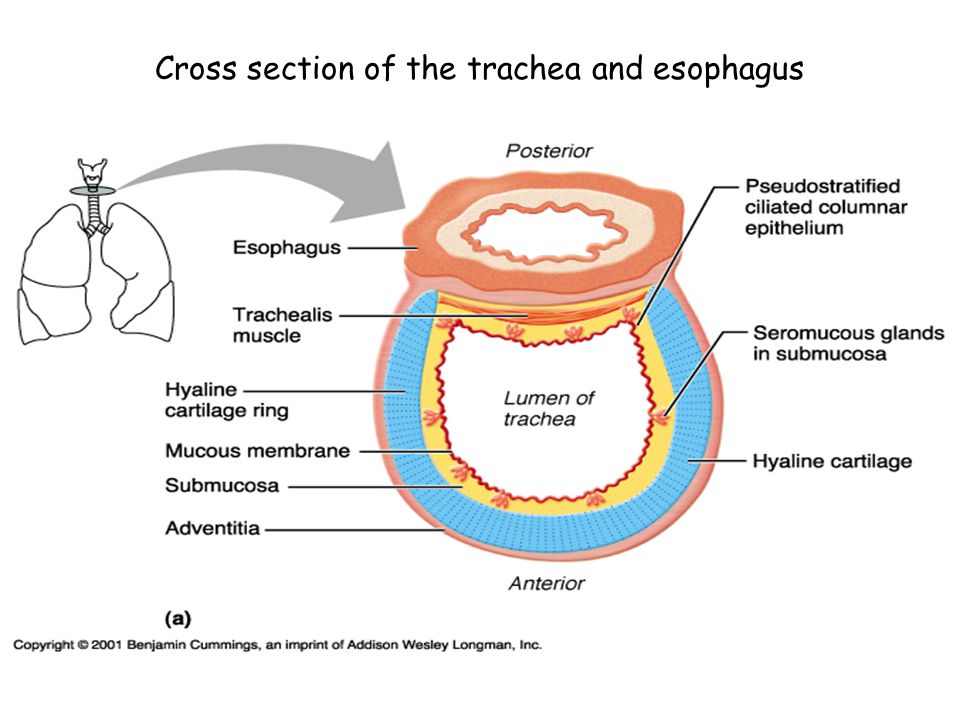
Trachea
A cartilaginous tube that connects the pharynx and larynx to the lungs, allowing the passage of air, and so is present in almost all air-breathing animals with lungs.

Bronchi
A passage of airway in the respiratory system that conducts air into the lungs. The first bronchi to branch from the trachea are the right main bronchus and the left main bronchus. These are the widest and enter the lungs at each hilum, where they branch into narrower secondary bronchi or lobar bronchi, and these branch into narrower tertiary bronchi or segmental bronchi. No gas exchange takes place in the bronchi.

Lungs
The primary organs of the respiratory system in humans. In mammals and most other vertebrates, two lungs are located near the backbone on either side of the heart. Their function in the respiratory system is to extract oxygen from the atmosphere and transfer it into the bloodstream, and to release carbon dioxide from the bloodstream into the atmosphere, in a process of gas exchange.

Nose
Air to come into the body through the nose. As it passes over the specialized cells of the olfactory system, the brain recognizes and identifies smells. Hairs in the nose clean the air of foreign particles. As air moves through the nasal passages, it is warmed and humidified before it goes into the lungs.
Respiratory acidosis is a condition that occurs when the lungs can't remove enough of the carbon dioxide (CO2) produced by the body. Excess CO2 causes the pH of blood and other bodily fluids to decrease.
Bronchodilator medicines and corticosteroids are used to reverse some types of airway obstruction.
